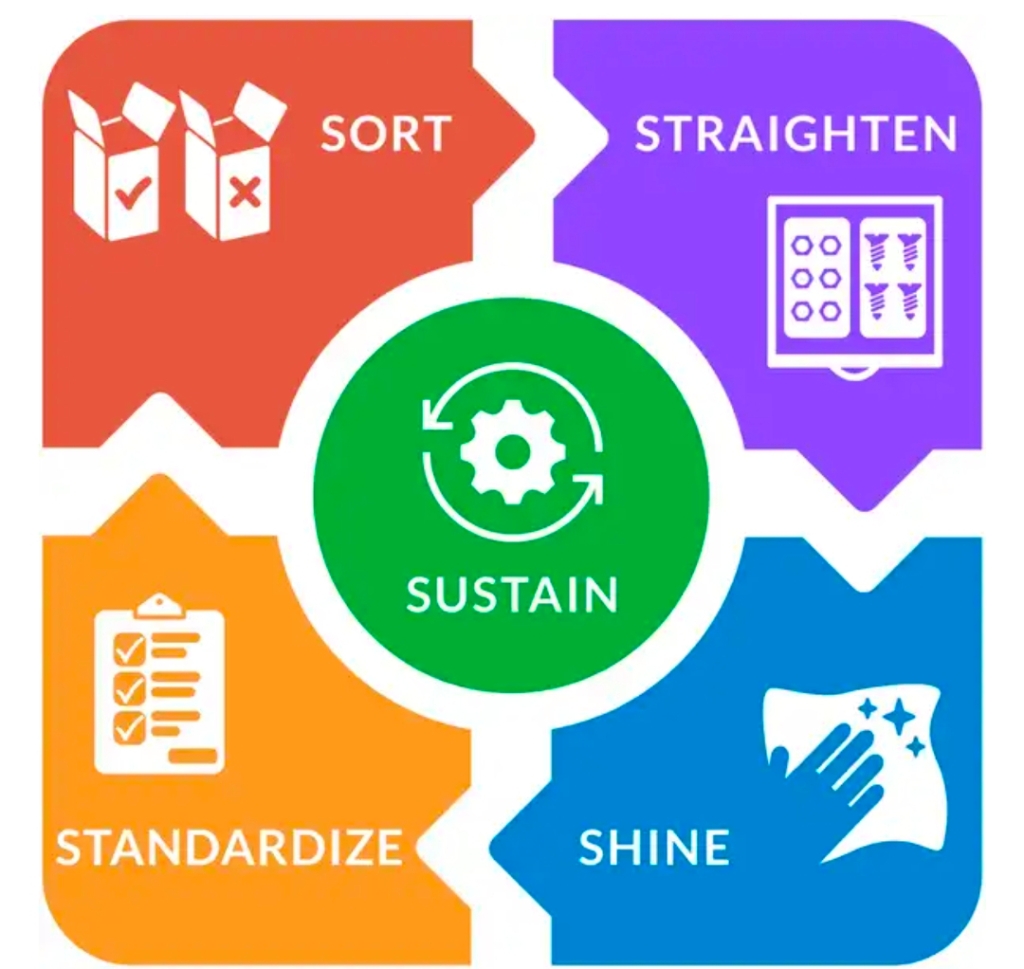
Introduction : In today’s competitive business landscape, organizations are constantly seeking ways to improve efficiency, productivity, and overall performance. One methodology that has proven to be a game-changer in achieving these objectives is the 5S system. Derived from Japanese management practices, 5S encompasses five key principles that revolutionize the workplace, fostering a culture of continuous improvement and transforming organizations for the better
Seiri (Sort) :- In the transformative 5S methodology, the crucial first step, Sort (Seiri), focuses on decluttering the workspace by identifying and eliminating unnecessary items. By creating a clean and organized environment, safety is enhanced, and operational efficiency is optimized. A practical technique involves using tagging or area marking during this phase, making the process more systematic. For instance, when cleaning a wardrobe, essential items are designated in a white zone, discarded items in red, and undecided ones in a yellow zone for future decisions. This simple yet effective approach sets the foundation for a productive and streamlined workplace, fostering a culture of continuous improvement and organizational excellence.
Seiton (Set in Order):- After successfully decluttering the workspace, the next transformative step, “Set in Order” (Seiton), begins with categorizing the remaining items. By carefully organizing and assigning specific locations for tools and materials, employees can easily access what they need, promoting seamless workflow and reducing the chances of errors. The principle optimizes productivity by eliminating time wasted searching for misplaced items, thus minimizing downtime. To illustrate, when cleaning the wardrobe, categorize the items based on their usage and decide on a designated place for each one. Then, place everything in its assigned spot, ensuring efficiency and order in the workspace. This systematic approach fosters a culture of efficiency and organization within the organization, driving lasting success
Seiso (Shine).:- In the transformative 5S methodology, the Shine principle plays a pivotal role in maintaining a clean and well-maintained workplace. By regularly cleaning the wardrobe, not only does it enhance its aesthetics, but it also ensures that the items in the white zone function optimally. Employees, encouraged to take pride in their workspace, approach this task with a sense of responsibility and attention to detail. This fosters a culture of efficiency and organization, resulting in increased operational efficiency and heightened employee satisfaction. With each item meticulously cleaned and placed in its designated spot, the wardrobe exemplifies the power of the Shine principle, contributing to a productive and harmonious working environment.
Seiketsu(Standardize):- In the Standardize (Seiketsu) phase of the 5S methodology, the focus shifts to maintaining the achieved improvements systematically. For the wardrobe, standardization involves creating clear and visual labels, indicating the name and quantity of each item. Additionally, responsibility tags are attached to ensure each item’s proper placement and organization. These consistent practices and procedures establish a uniform approach to wardrobe management across the organization. Standard operating procedures are developed, allowing teams to effortlessly follow the guidelines and share best practices. By embedding these standardized methods, continuous improvement becomes ingrained in the organizational culture, leading to sustained efficiency and a well-organized workspace that promotes safety, Quality and Productivity.
Shitsuke (Sustain):- In the Sustain (Shitsuke) phase of the 5S methodology, the organization establishes a culture of continuous improvement and employee engagement to ensure the long-term success of the improvements. For the wardrobe, clear guidelines are provided to employees, emphasizing the importance of maintaining the cleanliness and organization achieved through previous steps. Regular training sessions are conducted, empowering individuals to take ownership of their workspace and adhere to the 5S principles consistently. Periodic audits are implemented to assess adherence levels and identify areas for improvement. A feedback mechanism is established, encouraging employees to contribute ideas and suggestions for further enhancement. Through these initiatives, the organization creates a sustainable system, fostering a harmonious and efficient wardrobe while instilling a sense of responsibility and pride among employees.
Conclusion: The 5S methodology has proven to be a powerful tool in transforming organizations, transcending industries and borders. By implementing the five principles of Sort, Set in Order, Shine, Standardize, and Sustain, businesses experience improved productivity, enhanced safety, and increased employee morale. As organizations embrace 5S as a way of life, they unlock the full potential of their workforce and pave the way for sustained success and growth.
